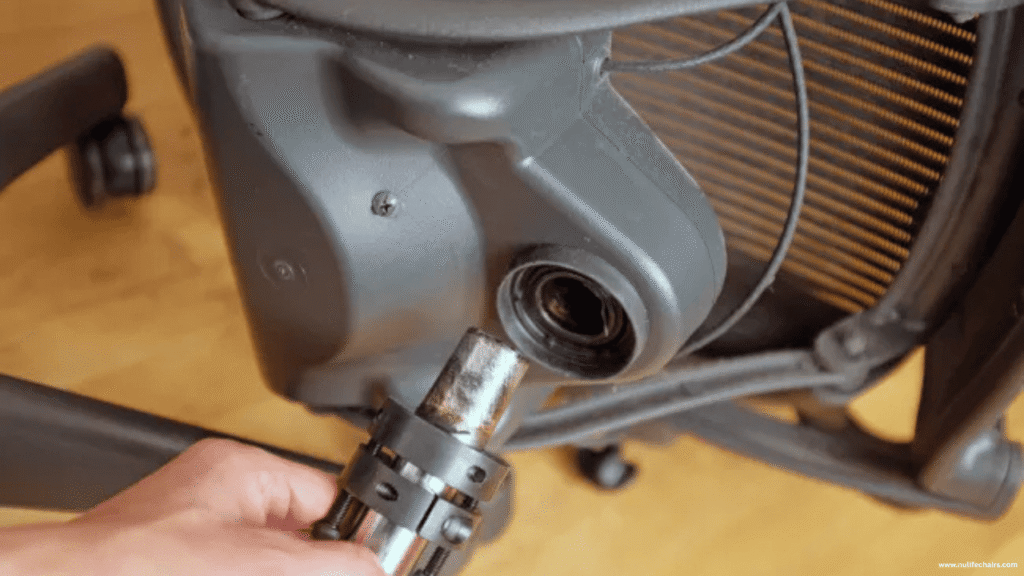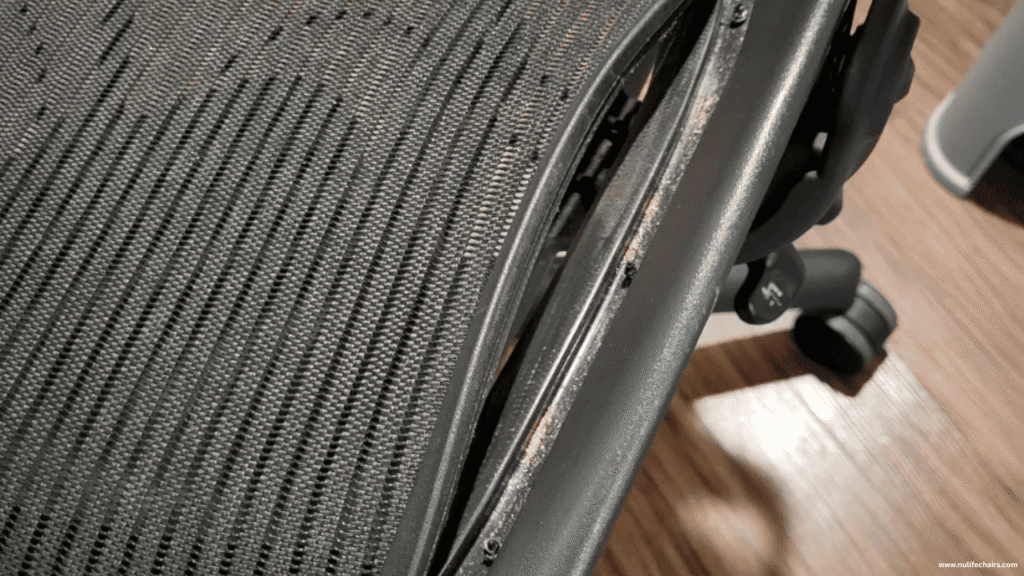Table of Contents
ToggleIntroduction
A good chair helps you sit up straight, relax, and stay comfortable while you work for a long time. But if you use it every day, it can steadily get weaker without you even knowing it. Most office chairs last between five and ten years, depending on how well they are manufactured, how often they are used, and how well they are taken care of. You might feel bad, get wounded, and not be able to work as well if you don’t fix broken things. Knowing which parts wear out first and how to fix or replace them keeps your chair comfy.
If your lower back hurts after work, the parts that support it may be worn out. People feel better and do better work when they take care of these difficulties right away.
Many folks don’t realize that their chair is falling apart. You can tell something is incorrect if the bases wobble or the chairs sink, for instance. Your chair will last longer, and you won’t have to buy a new one if you fix things before they break. Let’s talk about why chairs fail, which parts break first, and how to make them last longer.
Why Office Chairs Wear Out Over Time
No matter how good a chair is, it won’t last forever. There are many things that can cause an office chair to wear out more quickly:
What was used and how it was put together: How something is made affects how long it lasts. Chairs with steel frames, aluminum bases, and strong mesh or top-grain leather survive longer than chairs with cheap plastic or foam that isn’t particularly dense. Upholstery made of real leather and strong mesh lasts longer than upholstery made of flimsy cotton. Foam and plastic that aren’t very good can fall apart or break down in a few years. How often do you use it? Chairs that you sit in for more than eight hours a day wear out faster than chairs that you just sit in a few times a week. Wheels, cushions, and motors wear out faster when you use them a lot every day.
Weight Limit: There is a limit to how much weight each chair can hold. If you sit on or near the base, gas lift, and frame all the time, they will wear out faster. Big and Tall chairs are constructed with stronger parts that can handle more stress and last longer.
Regularly cleaning, oiling, and tightening the screws on a chair will help it last longer. If you don’t clean them, dust and dirt can get into the moving parts and make them less strong.
The weather can change things, such as how hot or cold it is, how humid it is, and how much sun there is. When the sun shines on plastic, it gets weaker and colors fade. When the air is dry, leather dries out. The wheels also wear out rapidly when you roll casters on rough floors.
What the maker says: The finest firms claim that the average lifespan of a high-quality ergonomic chair may vary depending on how well it is cared for and how often it is used. Herman Miller offers chairs like the Aeron that can last at least 12 years of normal workplace use. This is in keeping with their 12-year warranty, which covers both parts and labor. Steelcase also states that if you take care of them, its best-selling models, including the Leap and Gesture, should last 10 to 12 years. They say that cleaning them and tightening the nuts on a regular basis makes them work better. Both companies want you to know that their chairs are sturdy and will last a long time. However, if you use them a lot or don’t take care of them, they might not last as long.
Common Office Chair Parts That Wear Out First

Some parts of an office chair wear out faster than others since they are used more. If you know where the weak spots are, you can fix things fast or have spare parts on hand. We’ll go over each important part below, what to look for when it starts to wear out, why it happens, and what you can do to fix it (by fixing it or getting a new one).
This is an ancient office chair with a shredded seat and cushions that have lost their shape. The foam, fabric, and maybe even the support systems have all gotten worse. You may mend or replace some pieces of your chair before it becomes this bad if you see that it is wearing out quickly.
Chair Parts Wear & Tear: Signs, Causes, and Solutions
Every office chair will eventually break down, but if you look for early signs, you might be able to fix little problems before they get worse. Below is a list of the parts that break the most, what causes them to break, and how to fix your chair.
| Category | What You’ll See | Why It Happens | What You Can Do |
|---|---|---|---|
| Wheels and Casters | The wheels don’t turn smoothly. Wheels can crack or snap. The chair doesn’t feel right or creates noise. | Dust, hair, and other things have become stuck in the wheels. Rolling across floors that aren’t flat or carrying a lot of weight. Bearings could wear out over time. | Turn the chair over and clear out any hair or other rubbish that has gotten lodged in it. Pick heavy-duty casters or ones made for hardwood floors. Spray them with WD-40 or get a new set. |
| Armrests | The cushioning looks like it has cracks or tears. Your arms feel weak or shake. It makes a noise when you move it. | Everyday use, leaning, or friction. The screws come loose when you move. Parts rub together from frequent adjustment. | Replace with new gel or foam arm pads. Tighten or replace the screws if the brackets are worn. Apply silicone or WD-40 on moving parts. |
| Gas Lift / Air Cylinder | The chair slowly falls down. Height adjustment feels harsh or stiff. The lever isn’t working properly. | The seal on the cylinder has failed. Dirt or wear on the mechanism. Components are broken or misaligned. | Install a new gas lift. Clean and oil the moving parts. Check and replace the lever or lift if needed. |
| Cushion / Seat | The cushion seems flat or droopy. Fabric looks old or torn. Uneven support. | Foam loses shape over time. Everyday wear and friction from clothing. The seat base may be cracked. | Replace the foam or repair the upholstery. Replace seat cover or repair small tears. Inspect the seat pan and replace if necessary. |
| Backrest (Mesh or Fabric) | The mesh starts to sag. Tears or frays. The backrest moves or feels loose. | Normal wear and loss of tension. Sharp objects or constant rubbing. Loose bolts or worn connectors. | Replace the mesh or backrest panel. Repair or replace the fabric. Tighten screws and replace damaged parts. |
| Recline / Tilt System | Recline won’t stay locked. Tilt feels harsh or stiff. Noisy when leaning. | The locking mechanism is broken. Needs lubrication or new part. Springs or joints rubbing. | Replace the tilt lock part. Lubricate the knob and inspect for wear. Lubricate and check for damaged parts. |
| Base and Frame | The base has cracks or wobbles. Peeling or corroded paint. Chair doesn’t feel stable. | Overloading or long-term fatigue. Exposure to moisture. Bolts loosen over time. | Replace with a stronger base. Clean, repaint, or replace weakened metal. Tighten or replace the bolts and hardware. |
Your chair will last longer if you clean the parts, tighten the screws, and put some oil on it. It’s usually cheaper and faster to fix the broken part than to buy a new chair.
Maintenance Tips to Extend Chair Life
You can’t stop normal wear and tear, but regular cleaning and care can make your office chair last for years longer. Here are some simple yet effective ways to keep your chair in great shape and prevent early damage.
1. Keep It Clean and Dust-Free: When parts collect dirt or dust, they wear out faster. Make it a habit to wipe down plastic or leather surfaces with a damp cloth. For mesh or fabric areas, use a vacuum to remove debris trapped in crevices and moving parts. A clean chair not only lasts longer but also looks more professional and inviting.
2. Lubricate Moving Parts: Every six months, apply silicone spray or light machine oil to the springs, tilt, and swivel joints. This keeps all the mechanisms running smoothly and prevents metal parts from grinding against each other. Always remember to wipe away any excess oil — too much can attract dust and grime.
3. Tighten Screws and Bolts: Over time, daily use can loosen the screws and nuts that hold your chair together. Use the correct tool to check and tighten the connections on the arms, base, and seat. A solid frame provides better stability and helps reduce unnecessary strain on other parts.
4. Use Your Chair Carefully: Treat your chair with care to avoid putting extra stress on the components. Avoid leaning too far back, pulling too hard on the armrests, or using the chair as a step stool. Simple precautions like these go a long way toward preserving the cylinder, base, and overall structure.
5. Protect Your Floors and Wheels: If your workspace is carpeted, place a chair mat underneath. It keeps the wheels gliding smoothly, reduces strain on the casters, and prevents carpet wear. On hard floors, check for scratches and consider rubber or polyurethane casters for extra protection.
6. Inspect Regularly for Wear and Tear: Every few months, give your chair a quick inspection. Look for cracked bases, worn-out cushions, or wheels that no longer roll properly. Fixing small issues early — like tightening a wobbly base or replacing a stuck caster — saves you from bigger, more expensive repairs later.
Conclusion
You don’t have to wait for something really bad to happen, like a painful back, to see the signs of wear and tear and fix them. If your chair’s gas lift cylinders or wheels are broken, it can be a lot cheaper to fix them than to buy a new one. This is good for your business and your wallet since it saves you time and money by reducing waste and downtime.
In brief, keep an eye on the parts of your chair that wear out quickly, like the base, lift, casters, cushions, armrests, and tilt mechanism. If you keep up with routine maintenance and fix items as they break, you might be able to avoid major problems. A well-maintained, comfy chair can help you sit up straight and support your lower back. This is good for your health and your work. Fix your chair or get new parts before it breaks. Your body will appreciate you, and your chair will last a long time.
Frequently Asked Questions (FAQs)
Do mesh chairs wear out faster than leather ones?
Not all the time. Cheap mesh could sag or break faster than high-quality mesh, but high-quality mesh can last as long as leather. Leather is tough, but if you don’t take care of it, it might fracture or peel. To keep grit from ruining the mesh, clean it often and keep the leather out of the sun and heat.
Which chair brands last the longest?
Herman Miller and Steelcase are two well-known brands that are known for their long warranties (usually 12 years) and how long their products last. Aeron and Leap models can last more than ten years if you utilize them a lot. You can also trust the names Knoll, Humanscale, and Haworth. When an object has a long warranty, it usually means that it will last a long period.
Is it bad for my health to sit in a broken chair?
Yes, If your chair is broken or doesn’t support you effectively, it could pain your back and neck, make it hard for blood to flow, and make you sit up straight. If parts are loose or can’t be changed, it could be hard to sit comfortably and hurt over time. You need to get a new chair for your health and posture.
How often should you replace your office chair?
Most chairs last between 5 and 10 years; however, this depends on how well they are manufactured and how often they are used. It’s time to purchase new ones if your cushions are sagging, your frames are weak, or your adjustments are broken. High-end chairs will last longer if you take care of them or restore faulty parts. Don’t wait if it’s making you feel bad.
Where can I find good spare parts for my office chair?
The best place to start is with the company that made the chair, since they usually have authentic replacement components. You can also find nice parts in big grocery shops with hardware sections or on well-known sites like MyChairParts and OfficeReplacementParts. Always check to see whether something will fit (in terms of size and shape) before you buy it.
Is your office chair starting to look old?
You can either buy our high-quality replacement parts or upgrade to one of our ergonomic office chairs that will last a long time.


